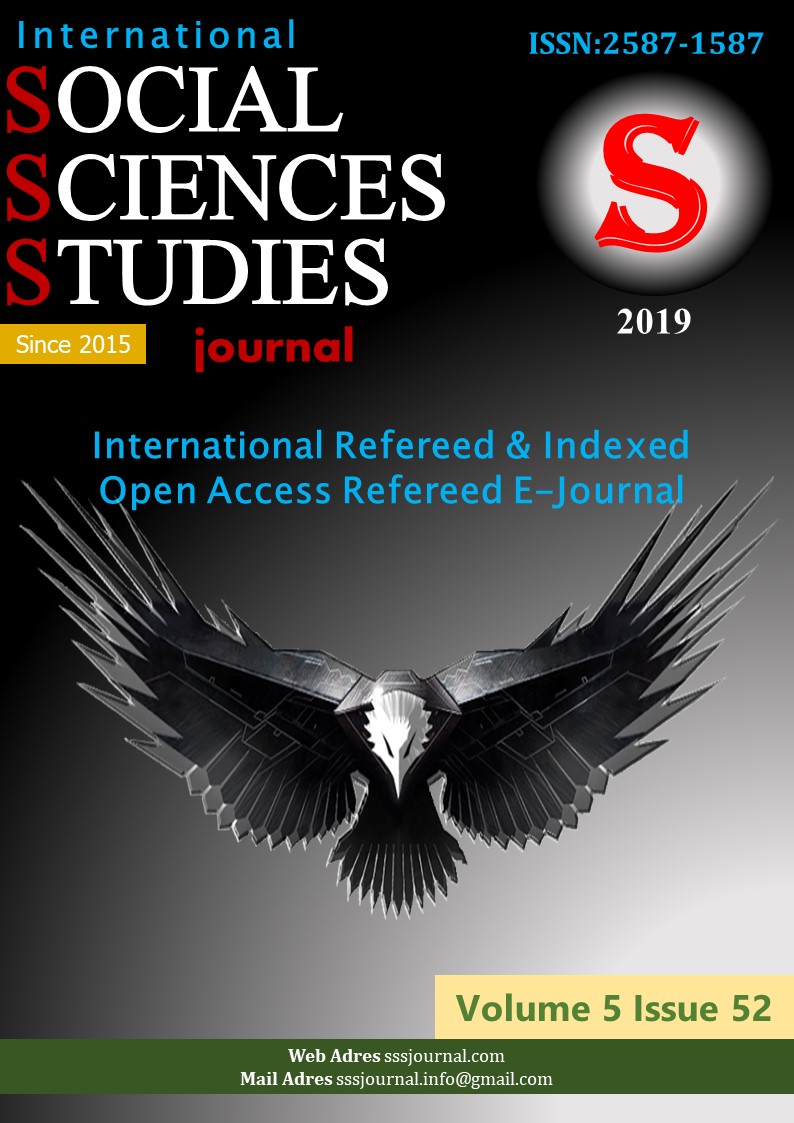Author :
Abstract
Endüstri 1’den Endüstri 4.0’a kadar olan zaman diliminde gelişen birçok teknoloji üretimi kolaylaştırmak ve verimliliğini arttırmak amaçlı kullanılmıştır. Üreticiler sektörlerinin ihtiyaçları doğrultusunda arz talep dengesini karşılamak adına gerek insan, gerek makina gerek ise bilişimsel anlamda mücadelelerini sürdürmektedirler. Endüstri 4.0, işletmelerin ve endüstrilerin içinde yaşanan gelişmelere ayak uydurmak zorunda oldukları, aksi takdirde rekabet gerisinde kalabilecekleri bir yaptırıma sahiptir. Mevcut çalışmada AHP ve Dematel metodları kullanılarak, Endüstri 4.0 sürecinde en çok önem verilen kriterlerin tespiti amaçlanmıştır. Yönetim Bilişim Sistemleri bölümü öğrencilerine düzenlenen anket sonuçları neticesinde, Analitik Hiyerarşi Prosesi Tekniği ve Dematel yöntemleri ile Endüstri 4.0 temel bileşenleri arasında önemli olan kriterlerin ağırlıkları hesaplanmıştır.
Keywords
Abstract
Many technologies developed over the period of Industry 1 to Industry 4.0 have been used to facilitate production and increase productivity. Producers continue their struggles in terms of both human, machine and informatics in order to meet the supply and demand balance in line with the needs of their sectors. Industry 4.0 has a sanction in which businesses and industries have to keep up with the developments within them, otherwise they may fall behind the competition. The present study aimed to determine the most important criteria in the Industry 4.0 process by using AHP and DEMATEL methods. As a result of the surveys conducted to the students of the Department of Management Information Systems, the weights of the criteria that are important and the main components of Industry 4.0 were calculated by the Analytical Hierarchy Process Technique (AHP) and The DEMATEL method.
Keywords
- Abdel-Basset, M., Manogaran, G.& Mohamed, M. (2018). Internet of Things (IoT) and its impact on
- Abdel-Basset, M., Manogaran, G.& Mohamed, M. (2018). Internet of Things (IoT) and its impact onsupply chain: A framework for building smart, secure and efficient systems, Future Generation Computer Systems, 86, 614-628.
- Aksakal, E., Dağdeviren, M. (2010) “Anp ve Dematel Yöntemlerı̇ ile Personel Seçimı̇ Problemine Bütünleşik Bir Yaklaşım”, Gazi Üniv. Müh. Mim. Fak. Der., Cilt 25, No 4, 905-913.
- Banger G. (2018) : Endüstri 4.0 Ekstra Darlion yayınları, 2.baskı, Eskişehir.
- Fontela, E., Gabus, A. (1974) “DEMATEL, innovative methods. Report no. 2 structural analysis of the world problematique”, Battelle Geneva Research Institute, 67-69.
- Gandhi, S., Mangha S.K., Kumar, P., Kumar, D. (2016) “A Combined Approach Using AHP AndDEMATEL For Evaluating Success Factors In Implementation Of Green Supply Chain ManagementIn Indian Manufacturing Industries”, International Journal of Logistics Research and Applications, Volume 19, Issue 6, 537-561.
- Görçün, Ö.F. (2017): Dördüncü Endüstri Devrimi Endüstri 4.0, Beta Yayınları, İstanbul.
- Kagermann, H., Helbig, J., Hellinger, A., & Wahlster, W. (2013). Recommendations for implementingthe strategic initiative INDUSTRIE 4.0: Securing the future of German manufacturing industry; final report of the Industrie 4.0 Working Group. Forschungsunion.
- Karaoğlan, S., Şahin, S. (2016) “DEMATEL ve AHP Yöntemleri İle İşletmelerin Satın AlmaProblemine Bütünleşik Bir Yaklaşım, DSLR Kamera Örneği”, İşletme Araştırmaları Dergisi, Cilt 8, No 2, 359-375.
- Kumar, R., Singh, S.P. & Lamba, K. (2018). Sustainable robust layout using Big Data approach: A key towards industry 4.0, Journal of Cleaner Production, 204, 643-659.
- Lasi, H., Fettke, P., Kemper, H. G., Feld, T., & Hoffmann, M. (2014). Industry 4.0, Business & Information Systems Engineering, 6(4), 239-242.
- Lee, J., Kao, H.A. & Yang, S. (2014). Service innovation and smart analytics for Industry 4.0 and bigdata environment. Product Services Systems and Value Creation. Proceedings of the 6th CIRP Conference on Industrial Product-Service Systems, Procedia CIRP, 16, 3 – 8.
- Liao, Y., Ramos, L.F.P., Saturno, M., Deschamps, F. & Szejka, A.L. (2017). The Role ofInteroperability in The Fourth Industrial Revolution Era, IFAC Papersonline, 50 (1), 12434-12439.
- Liu, S. X. (2016). Innovation design: made in China 2025, Design Management Review, 27(1), 52-58.
- Luthra, S. & Mangla, K. (2018). Evaluating challenges to Industry 4.0 initiatives for supply chainsustainability in emerging economies, Process Safety and Environmental Protection ,117, 168–179.Luthra, S., Garg, D. & Mangla, K. (2018). Analyzing challenges to Internet of Things (IoT) adoption and diffusion: An Indian context, Procedia Computer Science, 125, 733-739.
- Ly, P.T.M., Lai, W.H., Hsu, C.W. & Shih, F.Y. (2018). Fuzzy AHP analysis of Internet of Things (IoT) in enterprises, Fang-Yin Shih, Technological Forecasting & Social Change, 136, 1-13.
- Oliff, H. &Liu, Y . (2017).Towards Industry 4.0 Utilizing Data-Mining Techniques: a Case Study onQuality Improvement, The 50th CIRP Conference on Manufacturing Systems, Procedia CIRP, 63, 167 – 172.
- Öztuna, B. (2017) Dördüncü Sanayi Devrimi İle Çalışma Yaşamının Geleceği. Ankara: Gece Kitaplığı.
- Rüßmann, M., Lorenz, M., Gerbert, P., Waldner, M., Justus, J., Engel, P., & Harnisch, M. (2015).Industry 4.0: The future of productivity and growth in manufacturing industries, Boston Consulting Group, 9.
- Saturno, M., Ramos, L.F.P., Polato, F., Deschamps, F. & Loures, E.F. (2017). Evaluation ofinteroperability between automation systems using multi-criteria methods, Procedia Manufacturing, 11, 1837–1845.
- Selek, A. (2016). Endüstri Tarihine Kısa Bir Yolculuk. Erişim Adresi: http://www. endustri40. com/endustri-tarihine-kisa-bir-yolculuk/(5.12. 2017).
- Stock, T., & Seliger, G. (2016). Opportunities of Sustainable Manufacturing in Industy 4.0. 13thGlobal Confrence on Sustainable Manufacturing-Decoupling Growth From Resource Use, Elsevier B.V., 536-541.
- Taş, M., Özlemiş, Ş. N., Hamurcu, M., & Eren, T. (2017). Analitik hiyerarşi prosesi ve hedefprogramlama karma modeli kullanılarak monoray projelerinin seçimi, Harran Üniversitesi Mühendislik Dergisi, 2(2), 24-34.
- Wang, X., Li, L., Yuan, Y., Ye, P., & Wang, F.-Y. (2016). ACP-based Social Computing and Parallel Intelligence: Societies 5.0 and Beyond. CAAI Transactions on Intelligence Technology, 377-393.
- Industrial Internet Consortium Fact Sheet. (2013). Retrieved
- http://www.iiconsortium.org/docs/IIC_FACT_SHEET (13.02.2018)
- Türkiye Blog. (2016). Dördüncü Sanayi Devriminin Fırsatları: https://geturkiyeblog.com/dorduncu- sanayi-devriminin-firsatlari/ (Erişim Tarihi: 05.02.2019).





